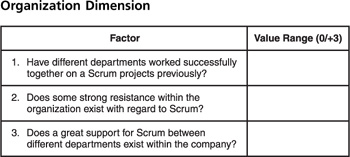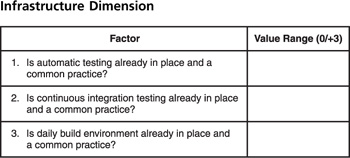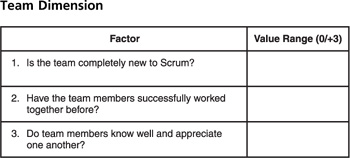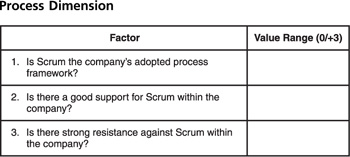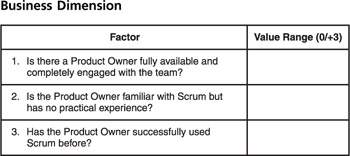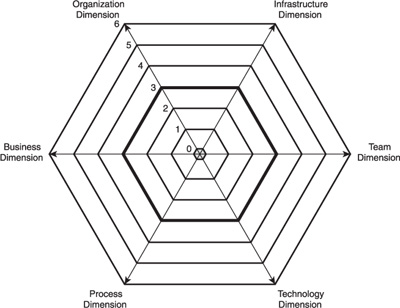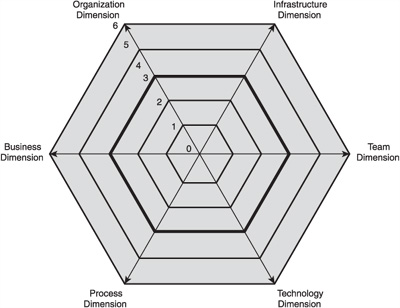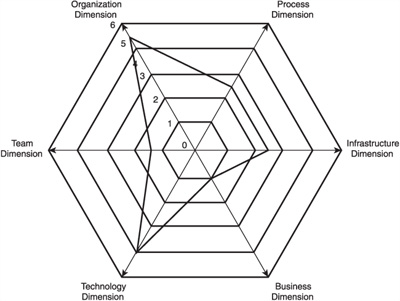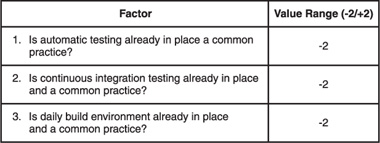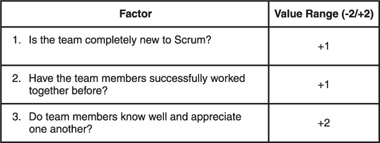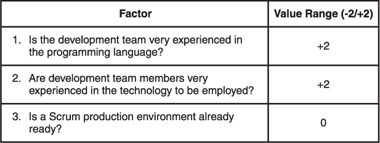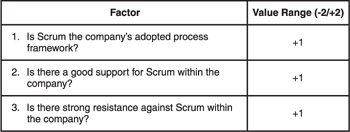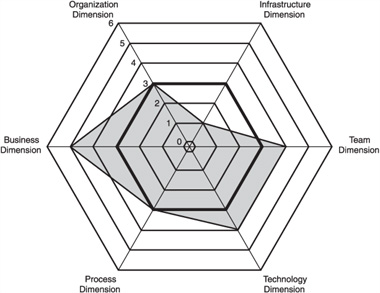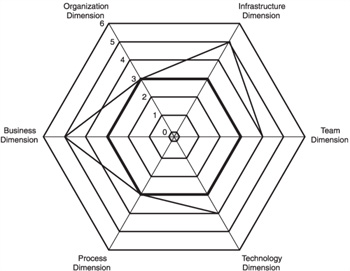It would be great to know what your chance of success is before you start your Scrum journey so that you can know where you should put your focus to improve your odds. In this chapter you will learn how to do a straightforward self-assessment of your project so that you can predict your chances of success before you begin.
A Simple Tool for Your Scrum Readiness Assessment
In Figure 13.1, you can see that the assessment is based on a scoring of six dimensions, which we have seen throughout the book.
Organization Dimension
This is mainly to assess if your different departments and teams are familiar with Scrum values and practices or not. The more they are, the better your experience will be.
Infrastructure Dimension
This is mainly to assess if your testing infrastructure is in place to allow your team to perform all the needed tests, which we mentioned in Chapter 6, “The Influence of Architecture Vision on Team Velocity and Software Quality.”
This is mainly to assess the level of relationship between your project team members, a key ingredient to a good teamwork.
Technology Dimension
This is mainly to assess whether your team is knowledgeable about the technology to be used. While not being a problem per se on a Scrum project, this is to help you know where your team stands on this so you can factor it into your estimate.
This is mainly to assess if your company has already had good knowledge or practical experience with Scrum or not.
Business Dimension
This is mainly to assess whether your business partner is quite aware of or familiar with Scrum requirements and practices. As you can guess, the more they are aware, the better you will be. Among the first benefit of the business knowing about Scrum is that you will likely get a product owner who is empowered, fully engaged, and knowledgeable.
Depending on the answers and scores you get for these, they will either help you or make your Scrum journey a rather difficult one.
The way the questionnaire works, the more your answer to a question is good or positive, the higher your score will be; the maximum (best) is +2 while the minimum (worst) is 0.
When you total up all your responses, you will get a score somewhere between 0 and 36.
If you get a total of 0 (minimum), it means that your project environment is such that you are going to have a hard time delivering on your project promises.
If you get a total of 36 (maximum), it means that your project environment is such that you have a maximum chance of being successful at delivering on your project promises.
If your score is over 18 (with +18 being the average), you are above average and can be very successful with Scrum, but it looks as if you have some issues to work on to improve your team’s ability to deliver. This could be to help the project team members work well together if they are new to one another or if they have had some bad experience on a previous project.
If you get a total of less than 18, this means that your chance of success is far less than average. You can still be successful, though, if you try hard to improve some issues in your project’s surrounding environment, thereby increasing your team’s ability to deliver.
Print out this questionnaire in Figures 13.2–13.7 and complete it to the best of your ability, and soon you will be on your way towards becoming a Scrum practitioner.
Here you are at the end of the questionnaire.
Depending on all the answers you get, you may get a minimum of 0, represented by a small dot in the middle of Figure 13.8.
However, if you are really lucky, you may get a maximum of 36, which covers the whole of Figure 13.9, with the second ring representing the average value.
If you are like some teams and companies, you may get a total value that averages around 18, with some high and some low scores on the different dimensions. Figure 13.10 illustrates this case.
If this is the case, it will be your responsibility to try to get the lower score to become higher as you go (or before you go) in order to improve on your project team’s chance of being successful with Scrum.
For illustration purposes, let’s go through the six dimensions and see how we scored when we first started to use Scrum in our business a few years ago (Figures 13.11–13.15).
Take a look at the score for each dimension in Figure 13.16. You will notice that while we were doing quite well with our organization, business, technology, team, and process dimensions, we need to make an effort to improve on our (testing) infrastructure dimension, which only got a score of 1.
Add the scores for the six environment dimensions to determine the total value we obtained for the self-assessment. In this case, the total is 20 (3+1+4+4+3+5). What this means to us is (1) that the environment makes our project team job neither difficult nor easy, and (2) therefore, the coefficient of multiplication we should use to do the story estimation is 1.
With this in mind and with our first sprint planning meeting under way, we were able to calculate our story point and obtain the table in Figure 13.17 for the first three stories, which had an UP (Unadjusted Point) of 7, 7, and 8.
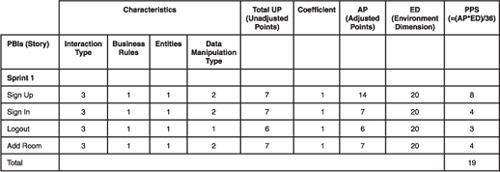
Figure 13.17. Estimation matrix for sprint 1. Legend: Remember that AP (Adjusted Points) = UP (Unadjusted Points) x C (Coefficient) and PPS (Points Per Story) = (AP x ED)/36.
As a result of our effort to improve on our testing infrastructure, we were able to improve our score on the testing dimension and obtain a total value of 25 for the self-assessment as can be seen in Figure 13.18.
With this result, we knew that we were able to improve on our coefficient of multiplication and, therefore, should use 0.5 (instead of 1 during sprint 1), which yields the table in Figure 13.19, knowing that the UP (Unadjusted Points) for the four new stories were all equal to 8.
The idea behind this assessment is that once you know where you land, you can then try to improve your score from that dimension until it reaches a certain value, like 4, which should give you a better hope to be more successful with Scrum.
All in all, your goal will be to get closer and stay close to the following targets:
Frequent software delivery.
Regular collaboration between the business and the software team.
Time-boxing everything or every meeting to avoid having things drag out too long.
Frequent inspect and adapt cycle.
Team self-management and empowerment.
And everything, at a sustainable pace (for team not to be burned out).
One of the ways to know what your chance of success is with Scrum is to perform an honest self-assessment of where you stand using some sort of Scrum project readiness matrix. In this chapter we provided you with an easy to use and straightforward matrix, comprising six dimensions.
Organization Dimension
Infrastructure Dimension
Team Dimension
Technology Dimension
Process Dimension
Business Dimension
Your answers and the scores you get for these dimensions will help or hinder your Scrum journey.
If you get a total of 36 (maximum), this means that your project environment is such that you have a maximum chance of being successful.
If you get a total of more than 18 (with 18 being the average), this means that your chances of success are above average, and although there are some issues, you can be very successful with Scrum.
If your total is less than 18, this means that your chance of success is below average.
If you get a total of 0 (minimum), this means that your project environment is such that you are going to have a hard time delivering on your project promises.
For illustration purposes, an example was given in this chapter of the scores of a start-up company when it started its first Scrum project for the six environmental dimensions. The company’s total was 20.
We also provided some suggestions in this chapter on how to improve your odds for success.


